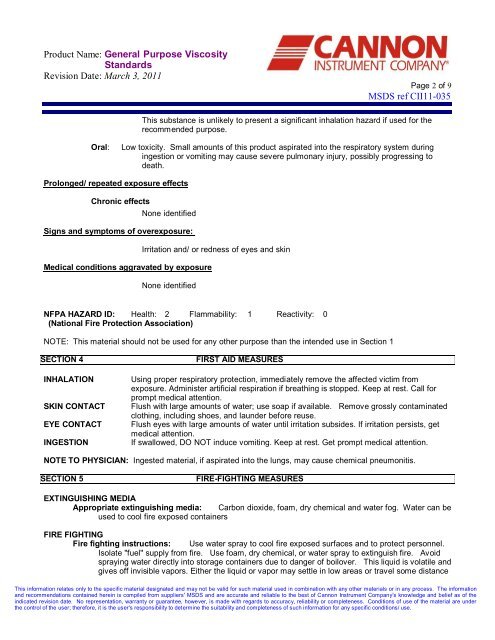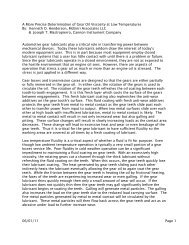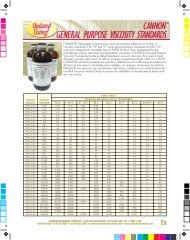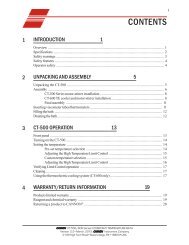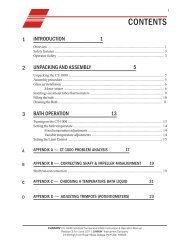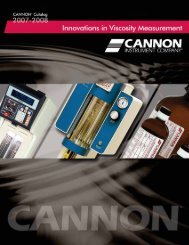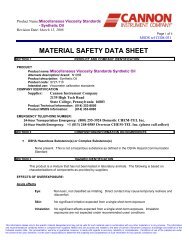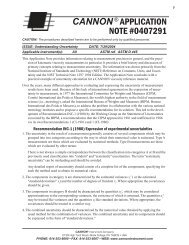N2 - Cannon Instrument Company
N2 - Cannon Instrument Company
N2 - Cannon Instrument Company
You also want an ePaper? Increase the reach of your titles
YUMPU automatically turns print PDFs into web optimized ePapers that Google loves.
Product Name: General Purpose Viscosity<br />
Standards<br />
Revision Date: March 3, 2011<br />
Page 2 of 9<br />
MSDS ref CII11-035<br />
This substance is unlikely to present a significant inhalation hazard if used for the<br />
recommended purpose.<br />
Oral:<br />
Low toxicity. Small amounts of this product aspirated into the respiratory system during<br />
ingestion or vomiting may cause severe pulmonary injury, possibly progressing to<br />
death.<br />
Prolonged/ repeated exposure effects<br />
Chronic effects<br />
None identified<br />
Signs and symptoms of overexposure:<br />
Irritation and/ or redness of eyes and skin<br />
Medical conditions aggravated by exposure<br />
None identified<br />
NFPA HAZARD ID: Health: 2 Flammability: 1 Reactivity: 0<br />
(National Fire Protection Association)<br />
NOTE: This material should not be used for any other purpose than the intended use in Section 1<br />
SECTION 4<br />
INHALATION<br />
SKIN CONTACT<br />
EYE CONTACT<br />
INGESTION<br />
FIRST AID MEASURES<br />
Using proper respiratory protection, immediately remove the affected victim from<br />
exposure. Administer artificial respiration if breathing is stopped. Keep at rest. Call for<br />
prompt medical attention.<br />
Flush with large amounts of water; use soap if available. Remove grossly contaminated<br />
clothing, including shoes, and launder before reuse.<br />
Flush eyes with large amounts of water until irritation subsides. If irritation persists, get<br />
medical attention.<br />
If swallowed, DO NOT induce vomiting. Keep at rest. Get prompt medical attention.<br />
NOTE TO PHYSICIAN: Ingested material, if aspirated into the lungs, may cause chemical pneumonitis.<br />
SECTION 5<br />
FIRE-FIGHTING MEASURES<br />
EXTINGUISHING MEDIA<br />
Appropriate extinguishing media: Carbon dioxide, foam, dry chemical and water fog. Water can be<br />
used to cool fire exposed containers<br />
FIRE FIGHTING<br />
Fire fighting instructions: Use water spray to cool fire exposed surfaces and to protect personnel.<br />
Isolate "fuel" supply from fire. Use foam, dry chemical, or water spray to extinguish fire. Avoid<br />
spraying water directly into storage containers due to danger of boilover. This liquid is volatile and<br />
gives off invisible vapors. Either the liquid or vapor may settle in low areas or travel some distance<br />
This information relates only to the specific material designated and may not be valid for such material used in combination with any other materials or in any process. The information<br />
and recommendations contained herein is compiled from suppliers MSDS and are accurate and reliable to the best of <strong>Cannon</strong> <strong>Instrument</strong> <strong>Company</strong>s knowledge and belief as of the<br />
indicated revision date. No representation, warranty or guarantee, however, is made with regards to accuracy, reliability or completeness. Conditions of use of the material are under<br />
the control of the user; therefore, it is the user's responsibility to determine the suitability and completeness of such information for any specific conditions/ use.


